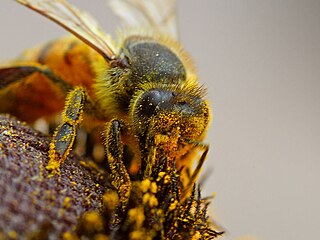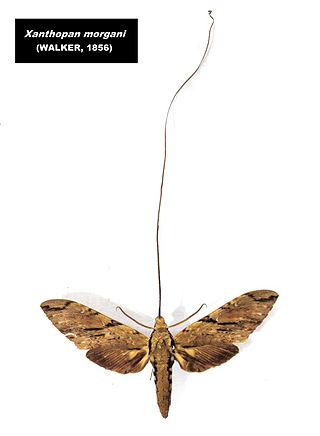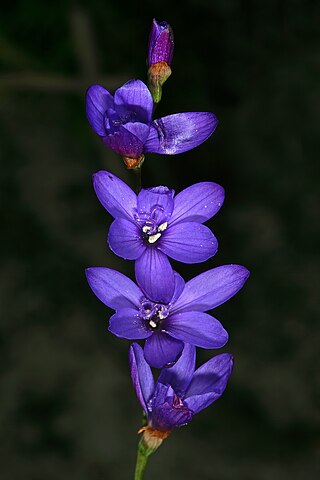
Petals are modified leaves that surround the reproductive parts of flowers. They are often brightly coloured or unusually shaped to attract pollinators. All of the petals of a flower are collectively known as the corolla. Petals are usually accompanied by another set of modified leaves called sepals, that collectively form the calyx and lie just beneath the corolla. The calyx and the corolla together make up the perianth, the non-reproductive portion of a flower. When the petals and sepals of a flower are difficult to distinguish, they are collectively called tepals. Examples of plants in which the term tepal is appropriate include genera such as Aloe and Tulipa. Conversely, genera such as Rosa and Phaseolus have well-distinguished sepals and petals. When the undifferentiated tepals resemble petals, they are referred to as "petaloid", as in petaloid monocots, orders of monocots with brightly coloured tepals. Since they include Liliales, an alternative name is lilioid monocots.

Malvaceae, or the mallows, is a family of flowering plants estimated to contain 244 genera with 4225 known species. Well-known members of economic importance include okra, cotton, cacao, roselle and durian. There are also some genera containing familiar ornamentals, such as Alcea (hollyhock), Malva (mallow), and Tilia. The genera with the largest numbers of species include Hibiscus, Pavonia, Sida, Ayenia, Dombeya, and Sterculia.

Heliconia is a genus of flowering plants in the monotypic family Heliconiaceae. Most of the 194 known species are native to the tropical Americas, but a few are indigenous to certain islands of the western Pacific and Maluku in Indonesia. Many species of Heliconia are found in the tropical forests of these regions. Most species are listed as either vulnerable or data deficient by the IUCN Red List of threatened species. Several species are widely cultivated as ornamentals, and a few are naturalized in Florida, Gambia, and Thailand.

In botany, a bract is a modified or specialized leaf, especially one associated with a reproductive structure such as a flower, inflorescence axis, or cone scale.

Amaryllis belladonna, the Jersey lily, belladonna-lily, naked-lady-lily, or March lily, is a plant species native to Cape Province in South Africa but widely cultivated as an ornamental. It is reportedly naturalized in many places: Corsica, Portugal, the Azores, Madeira, the Canary Islands, the Scilly Isles of Great Britain, the Democratic Republic of the Congo, Ascension Island, Australia, New Zealand, Mexico, Cuba, Haiti, the Dominican Republic, Chile, California, Texas, Louisiana, Mississippi, Michigan and the Juan Fernández Islands.

Entomophily or insect pollination is a form of pollination whereby pollen of plants, especially but not only of flowering plants, is distributed by insects. Flowers pollinated by insects typically advertise themselves with bright colours, sometimes with conspicuous patterns leading to rewards of pollen and nectar; they may also have an attractive scent which in some cases mimics insect pheromones. Insect pollinators such as bees have adaptations for their role, such as lapping or sucking mouthparts to take in nectar, and in some species also pollen baskets on their hind legs. This required the coevolution of insects and flowering plants in the development of pollination behaviour by the insects and pollination mechanisms by the flowers, benefiting both groups. Both the size and the density of a population are known to affect pollination and subsequent reproductive performance.

Zoophily, or zoogamy, is a form of pollination whereby pollen is transferred by animals, usually by invertebrates but in some cases vertebrates, particularly birds and bats, but also by other animals. Zoophilous species frequently have evolved mechanisms to make themselves more appealing to the particular type of pollinator, e.g. brightly colored or scented flowers, nectar, and appealing shapes and patterns. These plant-animal relationships are often mutually beneficial because of the food source provided in exchange for pollination.

Microtis, commonly known as onion orchids or mignonette orchids is a genus of about 20 species of plants in the orchid family, Orchidaceae. Onion orchids are terrestrial herbs with a single leaf at the base of the plant. They are similar to orchids in the genus Prasophyllum in that they have an onion-like leaf. The flowers are small but often scented and attractive to their insect pollinators. They are widespread in Asia, Australia and some Pacific islands.

Nectar is a viscous, sugar-rich liquid produced by plants in glands called nectaries, either within the flowers with which it attracts pollinating animals, or by extrafloral nectaries, which provide a nutrient source to animal mutualists, which in turn provide herbivore protection. Common nectar-consuming pollinators include mosquitoes, hoverflies, wasps, bees, butterflies and moths, hummingbirds, honeyeaters and bats. Nectar plays a crucial role in the foraging economics and evolution of nectar-eating species; for example, nectar foraging behavior is largely responsible for the divergent evolution of the African honey bee, A. m. scutellata and the western honey bee.

The Marcgraviaceae are a neotropical angiosperm family in the order Ericales. The members of the family are shrubs, woody epiphytes, and lianas, with alternate, pinnately nerved leaves. The flowers are arranged in racemes. The flowers are accompanied by modified, fleshy, saccate bracts which produce nectar. The flowers are pentamerous. The fruits are capsules.

A flower, also known as a bloom or blossom, is the reproductive structure found in flowering plants. Flowers consist of a combination of vegetative organs – sepals that enclose and protect the developing flower. These petals attract pollinators, and reproductive organs that produce gametophytes, which in flowering plants produce gametes. The male gametophytes, which produce sperm, are enclosed within pollen grains produced in the anthers. The female gametophytes are contained within the ovules produced in the ovary.

Aconitum lycoctonum is a species of flowering plant in the genus Aconitum, of the family Ranunculaceae, native to much of Europe and northern Asia. It is found in lowlands to the subalpine zone, mainly in forests and shaded habitats. Along with A. napellus, A. lycoctonum is of the most common European species of the Aconitum genus. They are also grown ornamentally in gardens, thriving well in ordinary garden soil. As such, A. lycoctonum can be found in North America, especially in eastern Canada, often in old gardens or as garden escapees.

Pollination syndromes are suites of flower traits that have evolved in response to natural selection imposed by different pollen vectors, which can be abiotic or biotic, such as birds, bees, flies, and so forth through a process called pollinator-mediated selection. These traits include flower shape, size, colour, odour, reward type and amount, nectar composition, timing of flowering, etc. For example, tubular red flowers with copious nectar often attract birds; foul smelling flowers attract carrion flies or beetles, etc.

A pseudanthium is an inflorescence that resembles a flower. The word is sometimes used for other structures that are neither a true flower nor a true inflorescence. Examples of pseudanthia include flower heads, composite flowers, or capitula, which are special types of inflorescences in which anything from a small cluster to hundreds or sometimes thousands of flowers are grouped together to form a single flower-like structure. Pseudanthia take various forms. The real flowers are generally small and often greatly reduced, but the pseudanthium itself can sometimes be quite large.

Marcgravia is a genus of plants in the Marcgraviaceae family commonly eaten by the dwarf little fruit bat. The genus is native to the Caribbean Islands, Central America, and South America, and genus is named in memory of the German naturalist Georg Marcgraf. The plant is visited by Thomas's nectar bat.

Xanthopan is a monotypic genus of sphinx moth, with Xanthopan morganii, commonly called Morgan's sphinx moth, as its sole species. It is a very large sphinx moth from Southern Africa and Madagascar. Little is known about its biology, though the adults have been found to visit orchids and are one of the main pollinators of several of the Madagascar endemic baobab (Adansonia) species, Adansonia perrieri or Perrier's baobab.

Nepenthes hemsleyana is a tropical pitcher plant endemic to Borneo, where it grows in peat swamp forest and heath forest below 200 m above sea level.

Geissorhiza aspera, also known as the blue satin flower or blou sysie, is a geophyte from South Africa.

Schwartzia is a genus of flowering plants belonging to the family Marcgraviaceae. It is found in tropical parts of South America, mainly within the rainforest. It has greenish, white, reddish or red coloured flowers.

Marcgravia pittieri is a species of flowering plant in the family Marcgraviaceae. It is visited by Thomas's nectar bat.

















